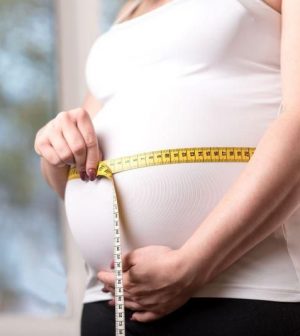- Skip Storing This Everyday Product in the Fridge Door
- Green Tea + B3 Pairing May Boost Brain Health
- Navigating Your Midlife Crisis: Embracing New Possibilities
- City Raccoons Showing Signs of Domestication
- Mapping the Exposome: Science Broadens Focus to Environmental Disease Triggers
- One Week Less on Social Media Linked to Better Mental Health
- Your Brain Changes in Stages as You Age, Study Finds
- Some Suicide Victims Show No Typical Warning Signs, Study Finds
- ByHeart Formula Faces Lawsuits After Babies Sickened With Botulism
- Switch to Vegan Diet Could Cut Your Greenhouse Gas Emissions in Half
Preeclampsia in Pregnancy a Bad Sign for Women’s Future Heart Health

A new study finds troubling information about a link between the pregnancy complication preeclampsia and future heart attack, even in younger women.
Danish researchers found a fourfold higher risk of heart attack and stroke within just seven years after delivery. Risks continued to be elevated more than 20 years later, according to findings published Jan. 26 in the European Journal of Preventive Cardiology.
Preeclampsia is a potentially dangerous condition when a pregnant woman has high blood pressure and high levels of protein in urine that indicate kidney damage (proteinuria), or other signs of organ damage.
“The high risk of cardiovascular disease after preeclampsia manifests at young ages and early after delivery,” said study author Dr. Sara Hallum, of the University of Copenhagen.
“This indicates that interventions to prevent heart attacks and strokes in affected women cannot wait until middle age when they become eligible for conventional cardiovascular screening programs,” Hallum said in a journal news release.
To study this, researchers used national registers in Denmark from 1978 to 2017. They grouped more than 1.1 million pregnant women into those who had one or more pregnancies complicated by preeclampsia and those with no history of the high blood pressure disorder.
All were free of cardiovascular disease before pregnancy. Researchers followed them for a maximum of 39 years for heart attack and stroke.
“This allowed us to evaluate exactly when cardiovascular disease occurs in women with and without preeclampsia, and to estimate risk in different age groups and at various durations of follow-up,” Hallum said.
The study found that up to 2% of those with preeclampsia in their first pregnancy had a heart attack or stroke within two decades of delivery. This compared with up to 1.2% of unaffected women.
The differences in risk became apparent seven years after delivery, researchers said.
“A 2% incidence of acute myocardial infarction and ischemic stroke should not be accepted as the cost of a pregnancy complicated by preeclampsia, particularly considering the young age of these women when they fall ill [below 50 years of age],” the authors wrote.
The research team found that overall, women with preeclampsia were four times more likely to have a heart attack within 10 years of delivery than their counterparts without preeclampsia. They were also three times more likely to have a stroke in that time frame.
These women still had twice the risk of heart attack or stroke more than 20 years after their babies were born.
Researchers also broke this down by age, finding that in women ages 30 to 39 with a history of preeclampsia, risk of heart attack was fivefold higher and stroke was threefold higher, compared to similar-age women who had no preeclampsia.
That means cardiovascular disease in those with a history of preeclampsia appears to persist throughout adulthood.
Worldwide, up to 8% of pregnancies involve preeclampsia. Protein in the urine and high blood pressure can show up after 20 weeks of pregnancy or after delivery. Other symptoms include severe headache, stomach pain and nausea.
“Women may mistake these for ‘normal’ pregnancy symptoms and thus not seek medical help until the condition becomes severe,” Hallum said. “Most cases are mild, but preeclampsia may lead to serious complications for the mother and baby if not treated in time.”
Pregnancy and the postpartum time are an opportunity to identify those at increased risk of cardiovascular disease, Hallum said.
“Our study suggests that the women most likely to benefit from screening are those who had preeclampsia after age 35 and those who had it more than once. Prevention should start within a decade of delivery, for example by treating high blood pressure and informing women about risk factors for heart disease such, as smoking and inactivity,” Hallum advised.
More information
The March of Dimes has more on preeclampsia.
SOURCE: European Society of Cardiology, news release, Jan. 25, 2023
Source: HealthDay
Copyright © 2025 HealthDay. All rights reserved.










